|
|
|
|
________ NOBUFUSA Note: See KO-BIZEN technicals |_________ _________ for appraisal overview ___|____ ___|____ ___|____ KANEHIRA SUKEHIRA TAKAHIRA - The SAMPIRA - ________ NOBUFUSA EI-EN 987 |____________ _____________ ________________________ ___|_____ ____|___ ____|____ | MORITSUNE KUNIKANE YASUTSUGU KAN-KO 1004 | - EI-EN 987 - ____|__ | YASUIYE SHO-RYAKU 1077 | ____|____ | SHIGENAGA TEN-NIN 1108 | "Three HIRAs" | ________________________ __________________________| ___|____ ___|____ ___|____ KANEHIRA EI-EN 987 SUKEHIRA KAN-KO 1004 TAKAHIRA |___________ |_____________ | O-WA 961 ___|_____ ___|____ ___|_____ ____|____ | YUKIMITSU KANEHIRA MITSUKANE SADATOSHI | | KAN-NIN 1017 CHO-WA 1012 CHO-RYAKU 1037 | |______________________ _____________ | ___|____ ___|____ ___|____ | NAGATOMI EI-SHO 1046 SUKEYUKI MUNEYORI | ___|____ EI-SHO 1046 SHO-KYU 1040 | SANEYORI SHO-HO 1074 | _____________________ _____________________________| ___|____ ____|____ ____|____ TAKAKANE MITSUMUNE CHO-GEN 1028 YOSHINORI | CHO-WA 1012 ____|____ CHO-HO 999 | KUNITSUNA EN-KYU 1069 | ____|__ | SADANAO KO-WA 1099 | |___________________________________________ ___|_____ ___|____ TAKAMITSU SHO-RYAKU 1077 YOSHIUJI EI-SHO 1046 |______________________ ___|____ ___|_____ ___|____ TAKAYASU EI-KYU 1113 TAKATSUNA TEN-EI 1110 NARITAKA HO-AN 1120 | ___|____ ___|____ | NARIKANE NIN-PYO 1151 NARITADA BUN-JI 1185 | _______________________| ___|_____ ___|_____ NARITSUNE GEN-EI 1118 KUNIYOSHI KAN-JI 1087 ___|_____ ___|_____ TAKASHIGE KYU-AN 1145 MORIMITSU KYU-AN 1145 ___|____ NARITAKA GEN-RYAKU 1184 _________________ ___|____ KO-BIZEN NOBUYASU NARITAKA TEM-PUKU 1233 KA-ROKU 1225 |
Note: See KO-BIZEN technicals for appraisal overview NOBUFUSA: His NOBU form: SHIN "Trust." He is known as the parent of "The Three HIRAs," SUKEHIRA, TAKAHIRA and KANEHIRA. A previous reference set the following erroneous classification: Two-character MEI: KO-BIZEN Three-character MEI: KO-ICHIMONJI Present study shows the three-character NOBUFUSA SAKU signature, that of the KO-BIZEN smith. The difficulty in differentiating between his works and KO-ICHIMONJI NOBUFUSA has been resolved to consideration of JI-BA. KO-BIZEN: -Wide YAKIBA, YUBASHIRI-like JI-BA -Three character MEI KO-ICHIMONJI: -YAKIBA with stronger NIE JI-BA -Two-character MEI His style is seen as a transition between the TOMONARI thin YAKIBA and MASATSUNE wide. NOBUFUSA steel is comparable to TOMONARI and yet his YAKIBA is deeper and seems more like that of MASATSUNE. It would be MASATSUNE YAKIBA on TOMONARI steel were it not that MASATSUNE's "CHOJI" is often a rippled SUGU or GUNOME like line pulled or opened from within by YO or ASHI where NOBUFUSA has the more traditionally defined and active CHOJI BA. NOBUFUSA: KOSHIZORI, KO-KISSAKI HEIAN TACHI SUGATA. Standing KO-ITAME where CHIKEI outlines MOKUME HADA patterns. MIDARE-UTSURI is possible. Varying CHU-width KO-CHOJI MIDARE of defined figures with YO and KO-ASHI in KO-NIE and NIOI-FUKASHI. Strong KINSUJI, especially in the lower. YAKIBA may loose some height in the lower. Signed above the ANA. |
| KO-BIZEN
NOBUFUSA GYO-BUTSU NOBUFUSA "JUMAN TABA" Imperial Property
Its name derives from a spectacular MUROMACHI price, JUMAN TABA of rice - "The 10,000 Bundle Sword" SHINOGI-TSUKURI, IHORI-MUNE, deep KOSHIZORI HEIAN TACHI. FUNBARI closes steadily to the KO-KISSAKI, its FUKURA seemingly abrupt in respect of the KO-SHINOGI. Standing KO-ITAME HADA mixes with MOKUME while JI-NIE dances in MIDARE-UTSURI veils. CHOJI rises are cleaved to an even ceiling in the upper, but only hinted through the MONOUCHI where suspended NIE SHIMA-BA hovers in disarray. YO and ASHI pile CHOJI in the mid. The YAKIDASHI falls away in a subtle JI-BA. BOSHI: Two small waves walk the FUKURA to KO-MARU. UBU NAKAGO signed above the
single ANA: |
Nobufusa
Tachi - Kokuho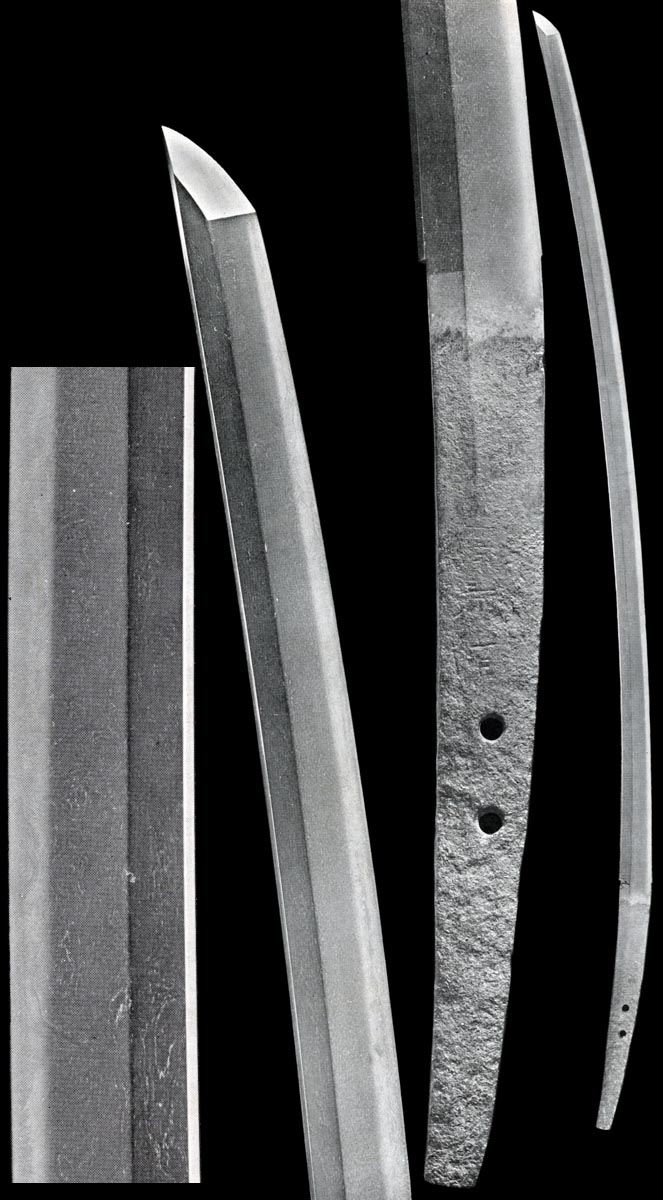 Nobufusa Tachi - Kokuho Nagasa: 74.9cm Moto-haba: 2.8cm Shinogi-Tsukuri, Ihori-Mune, Koshizori Funbari, Ko-Kissaki. Narrow Mihaba. Standing Itame Hada has thin Ji-Nie and Midare-Utsuri. Chu-Sugu Gunome-Choji Midare Ba has Sunagashi, Kinsuji and Hotsure creating Shimaba that pulls from figures. Hoso width Niju finds Ko-Maru Boshi. Ubu, Kurijiri Nakago has two Mekugi-ana. Signed on the Shinogi. Nobufusa Saku |
Nobufusa
Tachi - Kokuho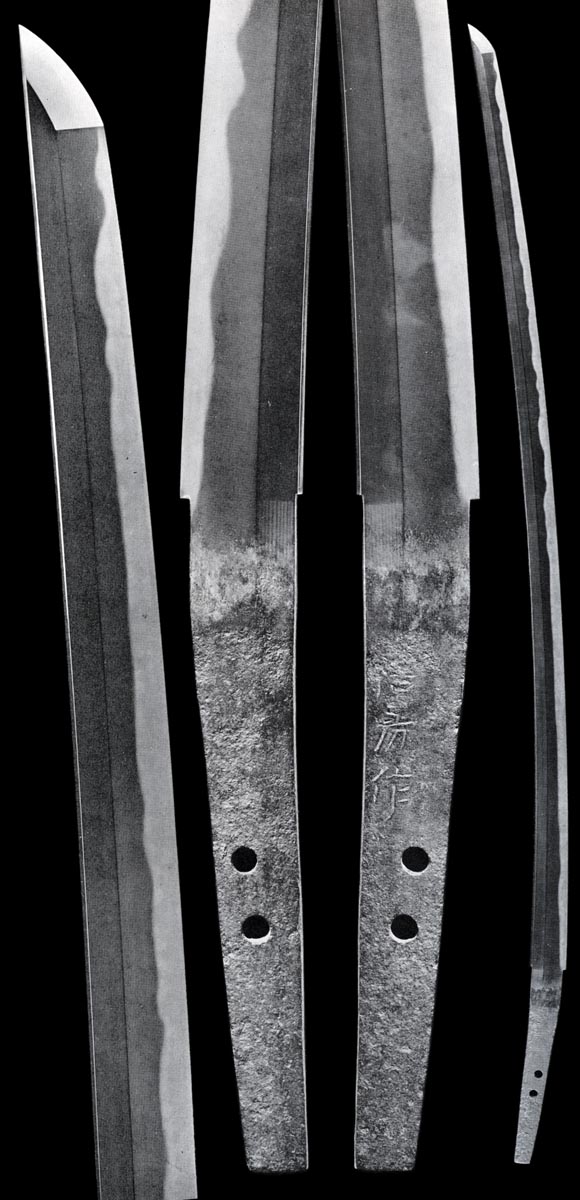 Nobufusa Tachi - Kokuho Nagasa: 76.2cm Moto-haba: 2.8cm Shinogi-Tsukuri, Ihori-Mune, Koshizori Funbari Tachi. Ko-Itame Hada has thin Ji-Nie. Nioi-Fukashi Ko-Nie Deki Choji-Midare Ba with Ko-Ashi under an undulating Notare hamon line. Midare-Komi Hakikake Boshi. Suriage Kirijiri Nakago has two Mekugi-ana. Signed on the Shinogi. Nobufusa Saku |
Nobufusa
- Kokuho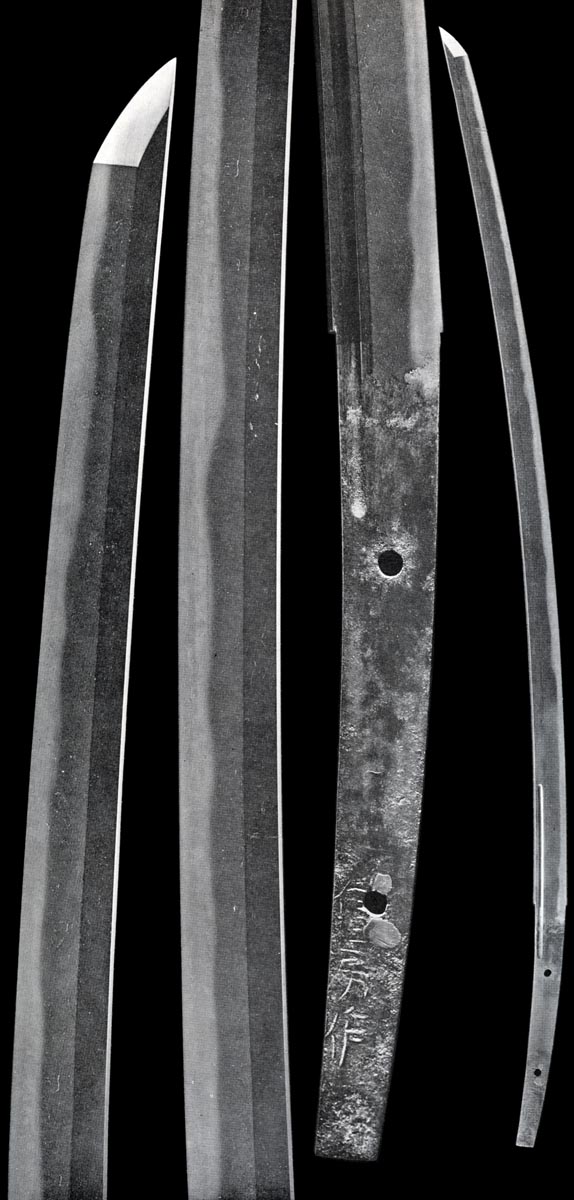 Nobufusa Tachi - Kokuho Nagasa: 71.7cm Moto-haba: 2.7cm Shinogi-Tsukuri, Ihori-Mune, narrow Mihaba, Ko-Kissaki Tachi. Standing Itame Hada has Ji-Nie and Chikei. Asaki-Notare holds strongly Nie-Deki Gunome Ko-Choji Midare Ba where Sunagashi, Kinsuji and Hotsure streak through tall figures. Shimaba and Tobi ride from the Habuchi Midare-Komi Hakikake Boshi. Suriage rounded Kirijiri Nakago has two Mekugi-ana. Signed on the Shinogi in the lower. Nobufusa Saku |
"The Three HIRAs" SAMPIRA
SUKEHIRA KAN-KO (t: NOBUFUSA): Born TEN-RYAKU 10, 956, the seventh son. Died in MAN-JU 1024. HEIAN style FUNBARI TACHI of strong arc in the KOSHI-MOTO that sees a straightening in its narrow reach toward a small KO-KISSAKI. Blades are thick and show healthy NIKU. Full length BO-HI is usual. SU-KEN and BONJI are seen. MOKUME HADA has JI-NIE. HOSO or CHU-width KO-MIDARE of KO-CHOJI BA in NIE find KINSUJI pulling from ASHI and YO. KO-BIZEN BOSHI becomes SUGU at the KISSAKI. KO-MARU and short-falling KAERI on evenly medium width. MEI: SUKEHIRA BIZEN-no-KUNI SUKEHIRA BIZEN-no-KUNI JUNIN SUKEHIRA MITSUKANE CHO-WA (f: SUKEHIRA): To KO-HEI 1058. MEI: MITSUKANE "Three HIRAs" SAMPIRA KANEHIRA EI-EN (f: NOBUFUSA): Father of KANEHIRA. Made KOTEMARU blade. Born: EN-CHO 923, died: CHO-ROKU or CHO-HO. Deeply curved TACHI will be 2 SHAKU 6 or 7 SUN to possibly 3 SHAKU. Blades will be made strong. KANEHIRA SUGATA may not appear HEIAN: being possibly wide with deep curve and little FUNBARI. BO-HI is possible, KAKU-DOME is possible. MOKUME HADA where NIE JI-BA creates a NIE-UTSURI. There will be CHIKEI. YAKIBA: An irregular KO-MIDARE of KO-CHOJI MIDARE BA in KO-NIE. His work touts two styles, narrow pattern with large KOSHIBA and wider pattern that undulates. There will be KINSUJI and ASHI in NIOI-FUKASHI. BOSHI follows suit to style. NAKAGO is long and curved. If KIJIMOMO, the cleft will be seated well to the middle of the tang. Of course, most NAKAGO of this age will not be UBU. An often repeated claim shows him in KAWACHI signing: HATA KANEHIRA and: KAWACHI-no-KUNI HATA KANEHIRA These signatures are also seen on blades of O-EI and later KAWACHI smiths. Always associate work to time. MEI: KANEHIRA BIZEN-no-KUNI KANEHIRA BIZEN-no-KUNI KANEHIRA SAKU |
KOKUHO
O-KANEHIRA
KO-BIZEN "The Three HIRAs" - SAMPIRA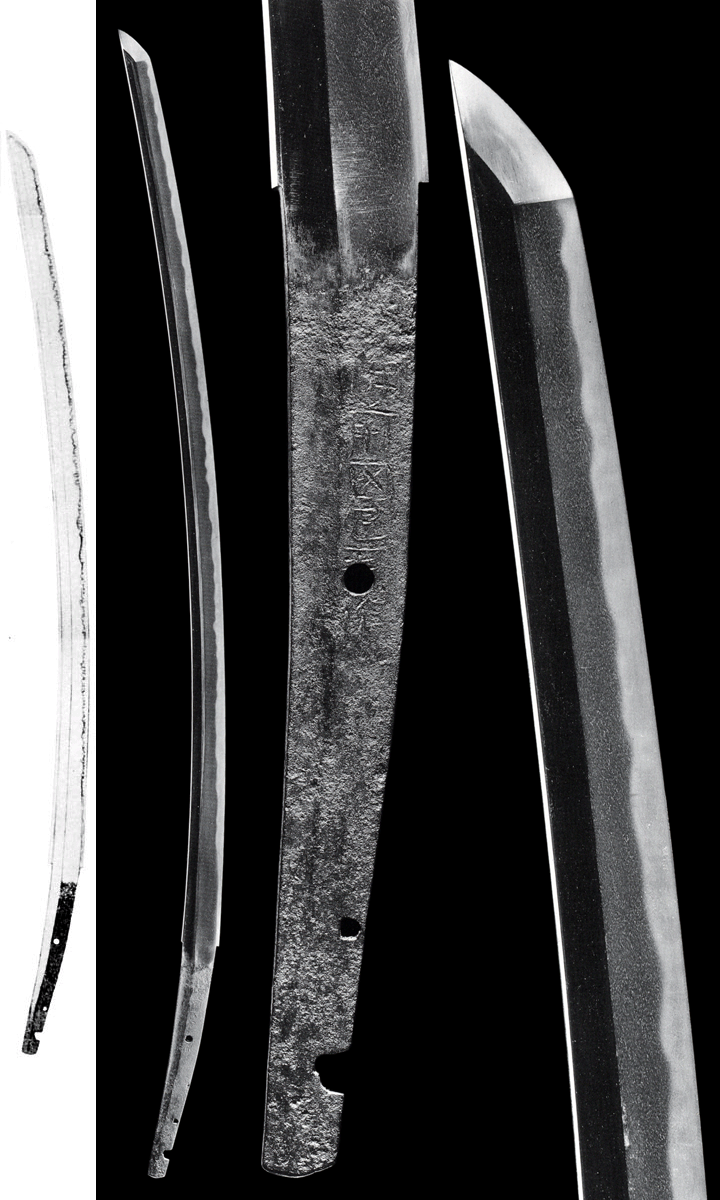 KOKUHO O-KANEHIRA National Treasure
A long possession of the IKEDA, it is considered one of the greatest of all Japanese swords. It was the favorite of MITSUMASA and said the presentation sword of his GEMBUKU adult initiation rights. One story has it the treasure of grandfather, TERUMASA, husband of TOKUGAWA IYEYASU's daughter; another the over-priced and unauthorized acquisition of overzealous KUMAZAWA RYOKAI, also known as BANZAN, the famous political professor, hired of the IKEDA, who later proved his own worse student when his governmental criticisms earned him a stay in the hoosegow. It is an ironic note that
of the long history of this great house, such a
small piece should become its greatest
inheritance. SHINOGI-TSUKURI, IHORI-MUNE, KOSHIZORI TACHI. The IKUBI-KISSAKI stands atop a huge and imposing HEIAN SUGATA where width through the upper couples a broad power to this otherwise thin blade. A BO-HI occupies the SHINOGI-JI from KO-SHINOGI through NAKAGO. CHIKEI badgers a condensed and moist KO-ITAME under faint NIE-UTSURI. KO-GUNOME shaped KO-CHOJI jut and justle. Clear NIOI-FUKASHI and KO-NIE follow delicate KO-ASHI while striating KINSUJI mimic a soft SUNAGASHI. Mountains and cliff fall into a smooth YAKIDASHI. A NIJU ghost stands off the relaxed but direct BOSHI. The gently curved UBU NAKAGO is HA-AGARI KURIJIRI with two present MEKUGI-ANA, a fill and a nearly 4 BU niche near the base. BIZEN-no-KUNI KANEHIRA SAKU
|
NOBUFUSA EI-EN: KO-CHOJI KO-MIDARE BA. See previous. YASUTSUGU KAN-KO (f: NOBUFUSA): KO-CHOJI MIDARE. Two character MEI. NOBUFUSA EN-KYU: ITAME HADA with JI-NIE. SUGUHA and CHOJI-MIDARE in deep NIOI. NOBUKANE EI-KYU (f: NOBUFUSA): KO-MOKUME. CHOJI-MIDARE with ASHI. MEI: BIZEN-no-KUNI NOBUKANE YOSHINORI HO-GEN: Worked to SHO-JI 1199. 6th son of NOBUFUSA. MOKUME HADA. NIOI-DEKI KO-CHOJI MIDARE BA. Large MEI. YOSHISUKE KEN-NIN (f: YOSHINORI): SO YOSHISUKE. KAGEYASU TEI-O (t: YOSHINORI): Work from JU-EI 1182. JI-NIE wets the JI. KO-NIE KO-MIDARE BA. |
Kunikane
- Kokuho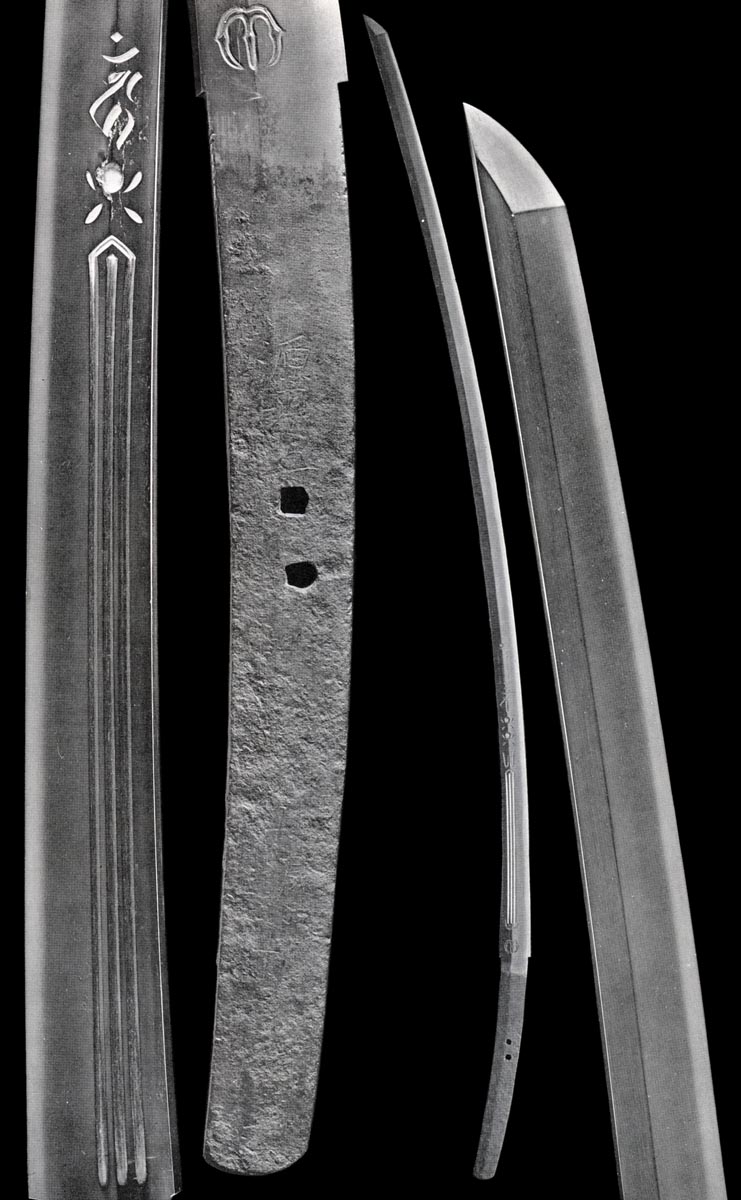 Kunikane San-Shaku Tachi - Kokuho Nagasa:107.9cm - San-Shaku Roku-Sun "Bamboo Tree" Moto-Haba: 3.6cm Shinogi-Tsukuri, Ihori-Mune, deeply curved Koshizori, Ko-Kissaki. Omote: Bonji, Rendai, Kuwagata and Suken Ura: Bonji, Rendai and Suken Standing Ko-Itame Hada has thick Ji-Nie. Suguha of Ko-Midare Ba with Ashi-iri. Asaki-Notare Boshi to Ko-Maru. Ubu Kurijiri Nakago has two Mekugi-ana. Minamoto Kuni(Kane) |
Takakane
Tachi - Kokuho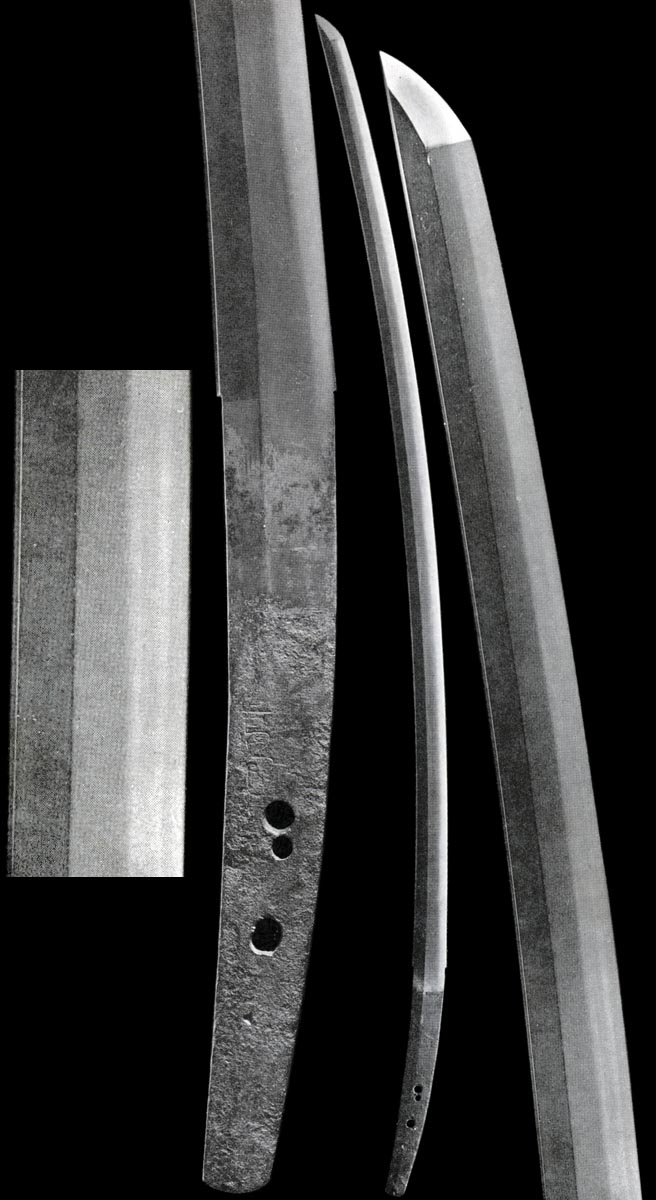 Takakane Tachi - Kokuho Nagasa:77.1cm - Moto-Haba: 2.7cm Shinogi-Tsukuri, Ihori-Mune, deeply curved Koshizori with Ko-Kissaki. Ko-Itame Hada has Ji-Nie and Midare-Utsuri. Wide Suguha of Choji Ko-Midare Ba with Ashi-iri and Yo where long lines of Shimaba join together to form Nijuba through the Habuchi. Hoso width Midare-Komi Boshi to Ko-Maru. Ubu Kurijiri Nakago has three Mekugi-ana. Takakane |
TAKAHIRA O-WA (f: NOBUFUSA): Born: EN-GI 18, 918, died: CHO-TOKU 4. O-CHOJI MIDARE BA. MEI: BIZEN-no-KUNI TAKAHIRA TAKAKANE CHO-WA (f: TAKAHIRA): Work to CHO-RYAKU 1037. MEI: TAKAKANE YOSHIUJI EI-SHO (f: TAKAKANE): TAKAYASU EI-KYU (f: YOSHIUJI): To CHO-GEN 1028. KUNIYOSHI KAN-JI (f: TAKAYASU): Work to CHO-SHO 1132. NARITSUNE GEN-EI (f: TAKAYASU): To CHO-GEN 1028. NARITAKA HO-AN: KITOJI. TAKAKANE line smith. Work to JI-SHO 1177. First signed NARIIYE. Old style KO-MIDARE BA in NIE becomes NIJUBA in places. NARITAKA NARITADA BUN-JI (t: NARITAKA): KO-MIDARE KO-CHOJI BA. YASUTSUNA GEN-NIN: Work from SHO-JI 1199. NIE KO-MIDARE of KO-CHOJI BA. YASUHISA KA-ROKU: NIE KO-MIDARE of KO-CHOJI BA. Also KEN-CHO YASUHISA follows. NORISHIGE KAN-KI: Often mistaken for ETCHU NORISHIGE. NORISHIGE sword: Is it early BIZEN? JI-NIE on standing ITAME shows CHIKEI. KO-BIZEN NIE JI-BA graces the JI. YAKIBA is in NIE. KO-MIDARE BA or KO-MIDARE of KO-CHOJI BA. MEI is completely different than ETCHU, somewhat small near the MUNE. YASUKIYO JO-EI: KO-KISSAKI, strong FUNBARI, KOSHIZORI TACHI. KO-MOKUME HADA shows JI-NIE and UTSURI. NIE JI-BA dresses evenly laid NIE KO-MIDARE or KO-CHOJI with ASHI and YO. BOSHI: KO-MARU. YOSHITSUGU BUN-EI: NIE JI-BA over KO-MIDARE of CHOJI BA. NOBUYASU KA-ROKU: Said to be in the KO-BIZEN NOBUFUSA line, a NOBUYASU seems, however, a popular creature in all NOBUFUSA lines. FUKUOKA NOBUYASU in KEN-CHO, FUKUOKA in BUN-EI and OSAFUNE NOBUNAOs' student in SHO-WA. MEI: NOBUYASU SAKU |
|